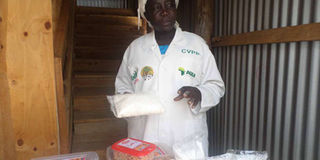Where cassava is a big money crop

Catherine Amusugut of Tangakona centre at their processing plant and farm in Busia County. PHOTO | ELIZABETH OJINA |NATION MEDIA GROUP
What you need to know:
- The society is not any different from the numerous farmer groups in the region, but what stands out about them is that they are milling good money from value added cassava.
- The farmers are cultivating cassava on not less than an acre.
- The common cassava varieties grown are MH95/083, MM96/2480 and MM96/3567 from the Kenya Agricultural and Livestock Research Organisation (Kalro).
Off the Kisumu-Busia highway after taking the Korinda junction, you will find Tangakona co-operative society.
The society is not any different from the numerous farmer groups in the region, but what stands out about them is that they are milling good money from value added cassava.
Catherine Amusugut, the manager, and other members of the outfit are drying cassava chips on a black polythene material when I arrive.
A few metres from where they are is a 25m by 8m solar dryer hosting cassava chips. The produce is spread on six racks made of wire-mesh.
“Our solar dryer has a capacity of 0.5 tonnes which it dries in three days. However, due to high demand, we dry the cassava chips outside as well,” says Amusugut.
The co-operative members cultivate cassava, which they process into chips, flour and animal feeds.
Steve Nakhulo, the secretary, says they have 300 members drawn from Busia County.
The farmers are cultivating cassava on not less than an acre.
“Some of our members are growing cassava on 15 acres while the least has an acre. Farmers growing the crop on big land use part of it for seed multiplication,” he says.
The common cassava varieties grown are MH95/083, MM96/2480 and MM96/3567 from the Kenya Agricultural and Livestock Research Organisation (Kalro).
“We visit farms and buy their cassava tubers. We weigh, sort and grade them before bringing to the processing plant at Tangakona centre,” says Nakhulo, noting they buy a kilo at Sh6.
The raw cassava is then peeled, washed and crushed in a mobile chipper.
“We normally squeeze all the liquid from it as we make cassava chips and spread them on the racks in the solar dryer,” explains Nakhulo.
Once the cassava chips are dried, they are either packed into one kilo bags or processed into flour. The group obtained Kenya Bureau of Standards certification for their flour in 2004.
“Our target is to get fine flour for the market. We use a diesel-powered posho mill but with finer sieve. Some buyers prefer dried chips, mix with other grains before processing into flour. Others use it for animal feeds,” he says.
The juice squeezed from cassava is rich in starch used in making pharmaceutical products. A kilo of the dried starch cost Sh200 while a kilo of flour and dried chips goes for Sh50, with the products sold in Busia, Kakamega and Siaya counties.
From the flour, the group further makes chapati, mandazi, cakes, doughnuts, crackers and porridge.
“To make the value added products, the cassava flour is mixed with wheat flour since the latter has a binding property, and then the standard methodology is used to cook them,” says Catherine, adding they started the group in 1999 with 30 farmes.
A doughnut goes for Sh10 and chapati Sh20. Cakes are sold for between Sh250 to Sh500 depending on the size and are baked on order, with the group’s sales hitting Sh30,000 at agri-shows.
Among the diseases cassava farmers have to contend with include cassava mosaic and cassava brown streak disease.
However, the Kalro varieties, from which they multiply their seeds, are resistant to diseases.
“In 2016, the cooperative got a tender to supply Busia County under Palweco initiative cassava cuttings worth Sh8 million. This remains their biggest business venture so far.”
Robert Musyoki, the chief research officer at Simlaw Seeds, says cassava mosaic and brown streak are viral diseases.
He says a farmer should step up hygiene standards and use cassava cutting from reputable suppliers to beat them.




